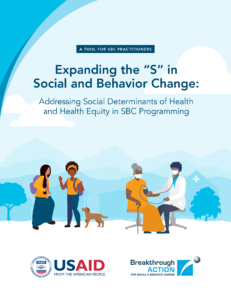
Family planning (FP) encompasses the conditions that allow individuals, couples, and families to anticipate and attain their desired number of children and the spacing and timing of their births, as well as the ability to not have children and raise whatever children they have in healthy and safe conditions when applying a reproductive justice lens. However, the ability of all people to do so remains constrained by a range of social and structural factors. These factors include social determinants of health or the conditions in the environments we occupy that affect our individual and collective ability to reach our full potential for health and well-being.
The social determinants of health can be categorized as follows: economic stability, education access and quality, health care access and quality, neighborhood and built environment, and social and community context.[1] They significantly impact people’s health, well-being, and quality of life, and it’s imperative that SBC practitioners, governments, and donors who set the agenda for FP/RH investments recognize their importance and address them and their relationship to systemic health and social inequities in order to advance health equity and improve FP/RH and related health outcomes at scale. Without adequately prioritizing the social and structural factors that undergird the inequities that inhibit access to FP information, services, and commodities, including contraceptives, women, men, and other gender-diverse people, across socioeconomic status, will not fully realize their reproductive intentions and achieve reproductive empowerment.
Expanding the “S” in Social and Behavior Change: Addressing Social Determinants of Health and Health Equity in SBC Programming serves as a thinking tool for practitioners as they consider how to identify, prioritize, and address social determinants of health through their programming. It presents key considerations and illustrative actions for advancing social and structural change and improving health equity through SBC programming that engages diverse partners and stakeholders in cross-sector partnerships and collaborations. Although the tool focuses on FP/RH, its content is broadly applicable to SBC programming across any health and development area.
[1] Office of Disease Prevention and Health Promotion, Office of the Assistant Secretary for Health, Office of the Secretary, U.S. Department of Health and Human Services. (n. d.). Social determinants of health. https://health.gov/healthypeople/objectives-and-data/social-determinants-health
LEARN MORE
ENGLISH
EN FRANÇAIS
Élargir le « S » du changement social et de comportement [PDF]
MORE INFORMATION
Recent Webinars
Why Do We Need to Elevate the S in SBC to Improve FP/RH Outcomes?
This webinar made the case for explicitly considering and addressing equity and social determinants of health in social and behavior change programming for family planning and reproductive health.
How Can SBC Programming Address Equity and Social Determinants of Health?
This webinar focused on how social and behavior change programming is well suited to addressing equity and social determinants of health in family planning/reproductive health.
How can Incorporating Social Accountability Into SBC Improve Equity?
This webinar focused on social accountability as a critical process that can be further leveraged across social and behavior change programming to address equity and social determinants of health to shape and influence family planning and reproductive health outcomes.


